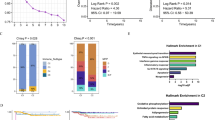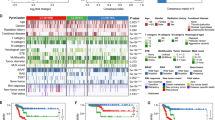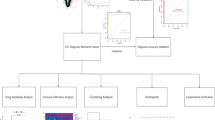Abstract
Background
Thyroid carcinoma (THCA) represents a prevalent form of cancer globally, with its incidence demonstrating an upward trend in recent years. Accumulating evidence has indicated that programmed cell death (PCD) patterns exert a vital influence on tumor progression. Nevertheless, the association between PCD and the prognosis of patients with papillary thyroid carcinoma remains to be elucidated. The current study endeavors to examine the link between PCD and the prognosis of thyroid cancer while concurrently developing a prognostic index based on PCD genes.
Materials and methods
Programmed cell death patterns were employed to construct the model and define clusters. Gene expression profile genomics and clinical data pertaining to 568 patients with thyroid cancer were sourced from the TCGA database. In addition, single-cell transcriptome data GSE184362 were procured from the Gene Expression Omnibus (GEO) database for subsequent analysis.
Results
The study harnessed six machine learning algorithms to create a programmed cell death signature (PCDS). Ultimately, the model developed via SVM was chosen as the optimal model, boasting the highest C-index. Moreover, the application of non-negative matrix factorization (NMF) led to the identification of two molecular subtypes of THCA, each characterized by distinct vital biological processes and drug sensitivities. The investigation revealed that PCDS is linked to chemokines, interleukins, interferons, and checkpoint genes, as well as pivotal components of the tumor microenvironment, as determined through a comprehensive analysis of bulk and single-cell transcriptomes. Patients with THCA and elevated PCDS values are more inclined to exhibit resistance to conventional chemotherapy regimens, yet may display heightened responsiveness to targeted therapeutic agents. Finally, we established a nomogram model based on multivariable cox and logistic regression analyses to predict the overall survival of THCA patients.
Conclusion
This research sheds new light on the role of programmed cell death (PCD) patterns in THCA. By conducting an in-depth analysis of various cell death patterns, a novel PCD model has been devised, capable of accurately predicting the clinical prognosis and drug sensitivity of patients with THCA.






Similar content being viewed by others
Availability of data and materials
We obtained two datasets for our study. The GSE184362 dataset is publicly available on the GEO database (http://www.ncbi.nlm.nih.gov/geo). We also utilized the Thyroid carcinoma (THCA) dataset from the TCGA repository (https://portal.gdc.cancer.gov/projects/TCGA), with accession code THCA. Both datasets are freely accessible for research purposes.
References
Aran D et al (2019) Reference-based analysis of lung single-cell sequencing reveals a transitional profibrotic macrophage. Nat Immunol 20(2):163–172
Bonati L, Tang L (2021) Cytokine engineering for targeted cancer immunotherapy. Curr Opin Chem Biol 62:43–52
Cackowski FC, Heath EI (2022) Prostate cancer dormancy and recurrence. Cancer Lett 524:103–108
Ding F et al (2022) Restoration of the immunogenicity of tumor cells for enhanced cancer therapy via nanoparticle-mediated copper chaperone inhibition. Angew Chem 134(31):e202203546
Forero A et al (2016) Expression of the MHC class II pathway in triple-negative breast cancer tumor cells is associated with a good prognosis and infiltrating lymphocytes. Cancer Immunol Res 4(5):390–399
Galluzzi L et al (2020) Consensus guidelines for the definition, detection and interpretation of immunogenic cell death. J Immunother Cancer 8(1):e000337
Ge EJ et al (2022) Connecting copper and cancer: from transition metal signalling to metalloplasia. Nat Rev Cancer 22(2):102–113
He Y et al (2018) Classification of triple-negative breast cancers based on Immunogenomic profiling. J Exp Clin Cancer Res 37:1–13
Hegde PS, Chen DS (2020) Top 10 challenges in cancer immunotherapy. Immunity 52(1):17–35
Huang D et al (2023) SYTL5 promotes papillary thyroid carcinoma progression by enhancing activation of the NF-κB signaling pathway. Endocrinology 164(1): bqac187
Jiang Y, Zhan H (2020) Communication between EMT and PD-L1 signaling: New insights into tumor immune evasion. Cancer Lett 468:72–81
Jiang P et al (2018) Signatures of T cell dysfunction and exclusion predict cancer immunotherapy response. Nat Med 24(10):1550–1558
Jin S et al (2021) Inference and analysis of cell-cell communication using Cell Chat. Nat Commun 12(1):1088
Kent WJ et al (2002) The human genome browser at UCSC. Genome Res 12(6):996–1006
Kondoh N, Mizuno-Kamiya M (2022) The role of immune modulatory cytokines in the tumor microenvironments of head and neck squamous cell carcinomas. Cancers 14(12):2884
Korotkevich G, Sukhov V, Budin N, Shpak B, Artyomov MN, Sergushichev A (2016) Fast gene set enrichment analysis. BioRxiv 060012. https://doi.org/10.1101/060012
Lawrence MS et al (2014) Discovery and saturation analysis of cancer genes across 21 tumour types. Nature 505(7484):495–501
Lee D, Seung HS (2000) Algorithms for non-negative matrix factorization. Adv Neural Inform Process Syst 13. https://proceedings.neurips.cc/paper_files/paper/2000/file/f9d1152547c0bde01830b7e8bd60024c-Paper.pdf
Liang M, Yang H, Fu J (2009) Nimesulide inhibits IFN-γ-induced programmed death-1-ligand 1 surface expression in breast cancer cells by COX-2 and PGE2 independent mechanisms. Cancer Lett 276(1):47–52
Liu YL et al (2021) Tetrathiomolybdate (TM)-associated copper depletion influences collagen remodeling and immune response in the pre-metastatic niche of breast cancer. NPJ Breast Cancer 7(1):108
Lu J, Tan M, Cai Q (2015) The Warburg effect in tumor progression: mitochondrial oxidative metabolism as an anti-metastasis mechanism. Cancer Lett 356(2):156–164
Lu X et al (2019) Immune signature-based subtypes of cervical squamous cell carcinoma tightly associated with human papillomavirus type 16 expression, molecular features, and clinical outcome. Neoplasia 21(6):591–601
Mardente S et al (2023) Extra-cellular vesicles derived from thyroid cancer cells promote the epithelial to mesenchymal transition (EMT) and the transfer of malignant phenotypes through immune mediated mechanisms. Int J Mol Sci 24(3):2754
Mermel CH et al (2011) GISTIC2.0 facilitates sensitive and confident localization of the targets of focal somatic copy-number alteration in human cancers. Genome Biol 12:1–14
Oehadian A et al (2005) Interferon (IFN)-β induces apoptotic cell death in DHL-4 diffuse large B cell lymphoma cells through tumor necrosis factor-related apoptosis-inducing ligand (TRAIL). Cancer Lett 225(1):85–92
Peng Y-Y et al (2016) NLRC5 regulates cell proliferation, migration and invasion in hepatocellular carcinoma by targeting the Wnt/β-catenin signaling pathway. Cancer Lett 376(1):10–21
Peng F et al (2022) Regulated cell death (RCD) in cancer: key pathways and targeted therapies. Signal Transduct Target Ther 7(1):286
Pozdeyev N et al (2018) Genetic analysis of 779 advanced differentiated and anaplastic thyroid cancers. Clin Cancer Res 24(13):3059–3068
Pu W et al (2021) Single-cell transcriptomic analysis of the tumor ecosystems underlying initiation and progression of papillary thyroid carcinoma. Nat Commun 12(1):6058
Ritchie ME et al (2015) limma powers differential expression analyses for RNA-sequencing and microarray studies. Nucleic Acids Res 43(7):e47–e47
Roemer MG et al (2018) Major histocompatibility complex class II and programmed death ligand 1 expression predict outcome after programmed death 1 blockade in classic Hodgkin lymphoma. J Clin Oncol 36(10):942
Stuart T et al (2019) Comprehensive integration of single-cell data. Cell 177(7):1888–1902
Su Z et al (2015) Apoptosis, autophagy, necroptosis, and cancer metastasis. Mol Cancer 14:1–14
Subramanian A et al (2005) Gene set enrichment analysis: a knowledge-based approach for interpreting genome-wide expression profiles. Proc Natl Acad Sci 102(43):15545–15550
Tang D et al (2019) The molecular machinery of regulated cell death. Cell Res 29(5):347–364
Tsvetkov P et al (2022) Copper induces cell death by targeting lipoylated TCA cycle proteins. Science 375(6586):1254–1261
Wang Q et al (2018) Immunogenic cell death in anticancer chemotherapy and its impact on clinical studies. Cancer Lett 438:17–23
Wang K et al (2020) Inhibition of PAK1 suppresses pancreatic cancer by stimulation of anti-tumour immunity through down-regulation of PD-L1. Cancer Lett 472:8–18
Yoshihara K et al (2013) Inferring tumour purity and stromal and immune cell admixture from expression data. Nat Commun 4(1):2612
Zou Y et al (2022) Leveraging diverse cell-death patterns to predict the prognosis and drug sensitivity of triple-negative breast cancer patients after surgery. Int J Surg 107:106936
Funding
This study had no form of funding.
Author information
Authors and Affiliations
Contributions
ZF, JZ designed this project. QZ performed the bioinformatics analysis. ZF wrote the manuscript and supervised the project. QZ, YD, YX, XS, QC, YZ and JM performed the data review and modified manuscript. All authors read and approved the manuscript.
Corresponding authors
Ethics declarations
Conflict of interest
The authors declare no competing interests.
Ethical approval
Not applicable.
Consent to participate
Not applicable.
Consent for publication
Not applicable.
Additional information
Publisher's Note
Springer Nature remains neutral with regard to jurisdictional claims in published maps and institutional affiliations.
Supplementary Information
Below is the link to the electronic supplementary material.


Rights and permissions
Springer Nature or its licensor (e.g. a society or other partner) holds exclusive rights to this article under a publishing agreement with the author(s) or other rightsholder(s); author self-archiving of the accepted manuscript version of this article is solely governed by the terms of such publishing agreement and applicable law.
About this article
Cite this article
Feng, Z., Zhao, Q., Ding, Y. et al. Identification an innovative classification and nomogram for predicting the prognosis of thyroid carcinoma patients and providing therapeutic schedules. J Cancer Res Clin Oncol 149, 14817–14831 (2023). https://doi.org/10.1007/s00432-023-05252-6
Received:
Accepted:
Published:
Issue Date:
DOI: https://doi.org/10.1007/s00432-023-05252-6




